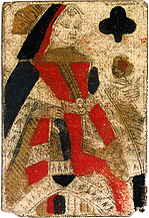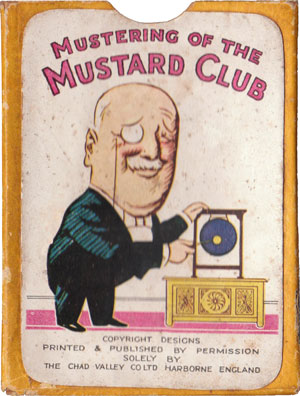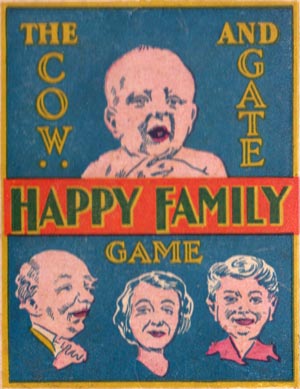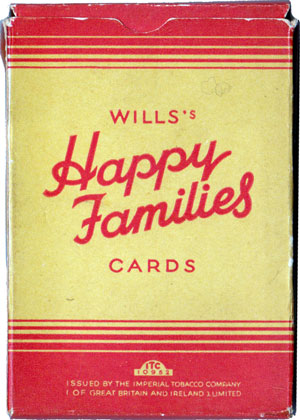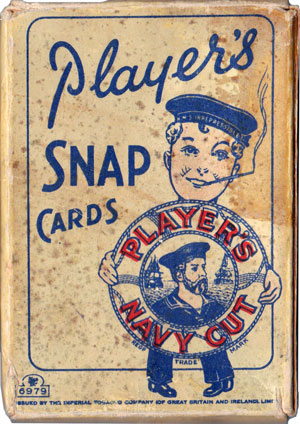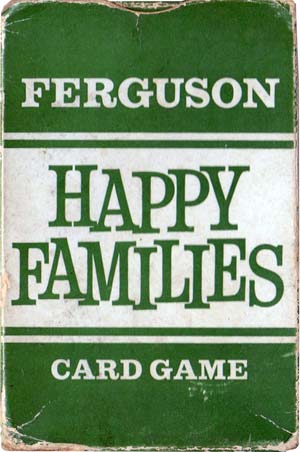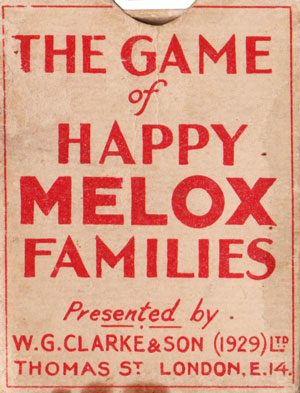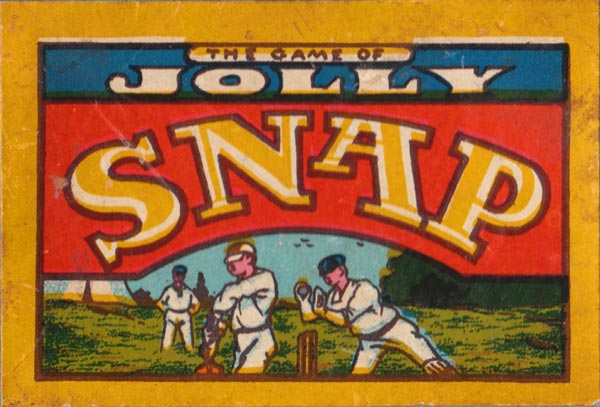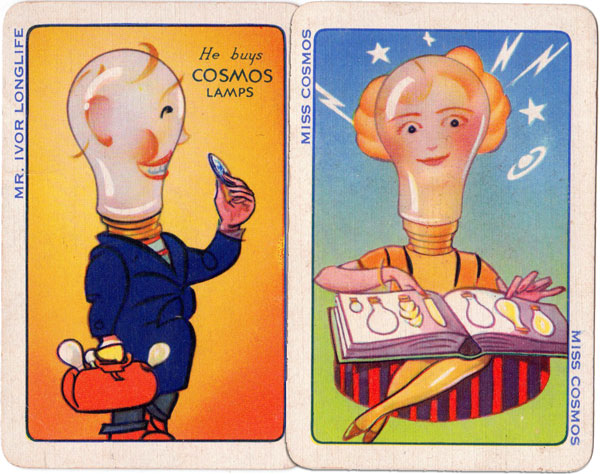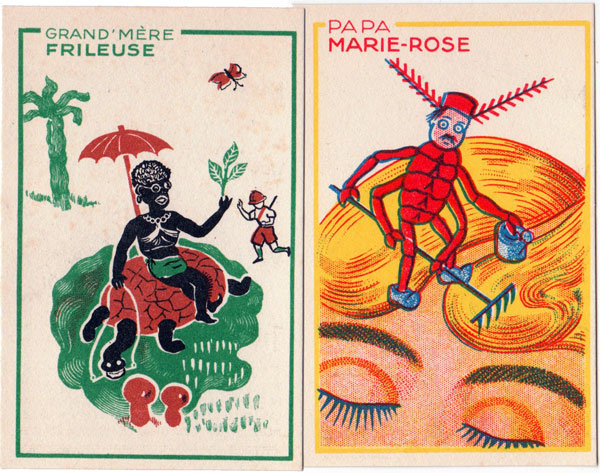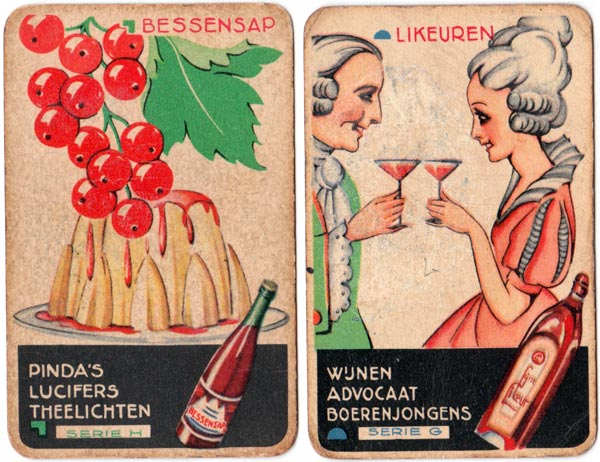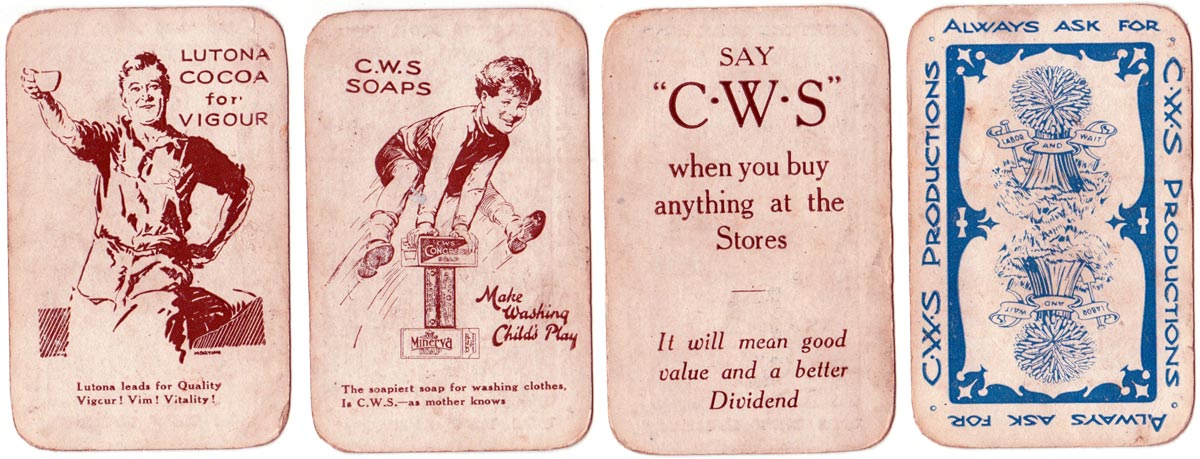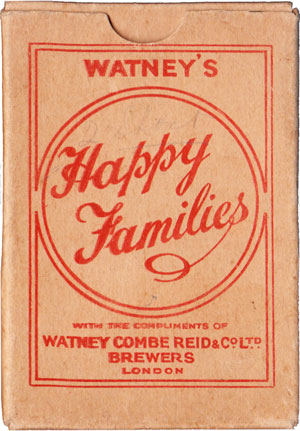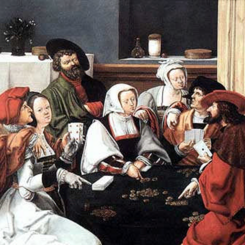Standard and Non-standard Playing Cards
Standard playing cards are based upon traditional designs and are used for card games.
Above: standard playing card, 1700
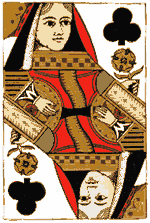
Above: standard playing card, 1865
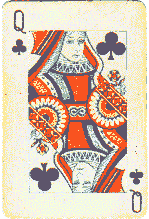
Above: standard playing card, 1935
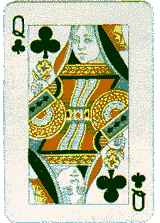
Above: standard playing card, 1965
Standard Playing Cards
Standard playing cards are those in which the court card figures are based upon traditional designs whose features do not change much over time. Players recognise the cards immediately and expect to use these for everyday card games. The number cards are arranged clearly and logically. Standard packs are made by most manufacturers, although there may be different standard patterns in different regions within a country. There are also several different national suit-systems, alternative court card hierarchies as well as the number of cards in a pack.
The illustrations (right) show how English playing card designs have evolved from full length figures, with square corners and no indices, to double-ended ones, with the addition of indices, although the same basic designs are always discernible.
During the 19th century the court cards were often flipped horizontally so that the pip sign and index lie at the top left-hand corner, to make fanning the cards more convenient.
By around 1880, rounded corners had become the accepted norm in England. The Printer and Stationer of January 1880 reported that "… it appears that most of our card manufacturers make round cornered cards now - their convenience being undeniable." However, square cornered cards were still produced until around the turn of the century.

"Life is a pack of cards.
Childhood's best cards are hearts;
youth is captured with diamonds;
middle age is conquered by a club,
while old age is raked in by the insatiable spade."
One standard pattern in particular enjoyed great success and was widely imitated - the Paris pattern. Derivatives of several other French regional patterns also became new patterns in many European countries more►
Non-Standard Playing Cards
Non-standard playing cards are those in which the court cards, pip cards, aces and/or jokers have deviated from the traditional, 'standard' pattern and have been stylised, decorated or re-designed. For example, fantasy historical court cards, humorous cartoons, decorative aces, and so on. Sometimes the court cards are representations of political personalities. A pack of cards may be produced to honour a royal commemoration, a new tourist attraction or the next millennium. Sometimes the shape of the cards is different. These types of card are a distraction to serious card players, but often sought by collectors.
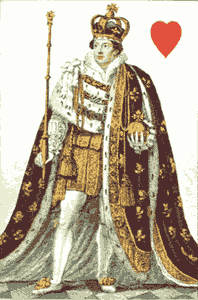
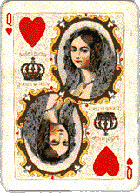
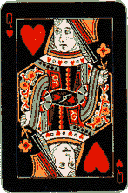
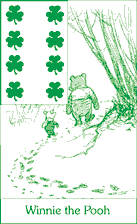
Above: non-standard English playing cards, c.1820-1999. Not so easy to recognise at first glance.
Advertising Playing Cards
Advertising playing cards display advertising messages, either on the reverse of the cards, or else on the pip cards, court cards, aces, jokers or even the box. They may be given away freely, but not always easy to get. Some of the more popular collector's advertising themes include breweries, shipping lines, and household products. The style of advertising on playing cards changes over the decades, due to changing technologies, fashions and taste.
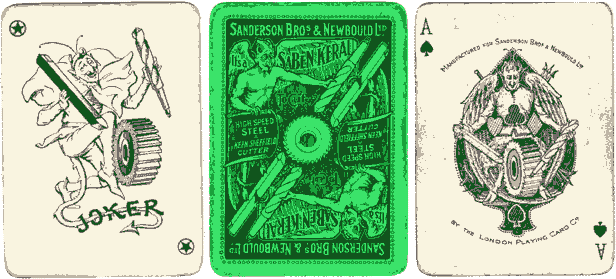
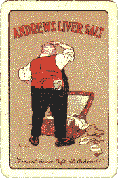
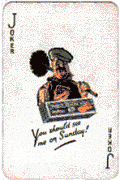
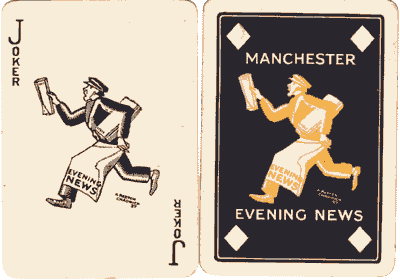
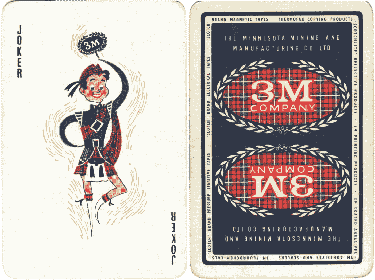
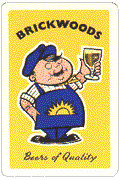
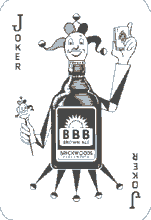
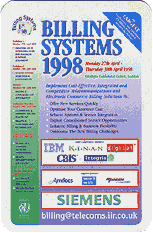
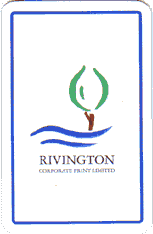

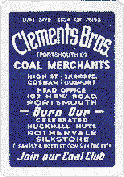
With the covergence of digital technologies towards the end of the 20th century, the cost of producing custom playing cards, i.e.non-standard, fell whilst old-fashioned technologies became obsolete. Small custom print runs became feasible with photoshopped artwork inserted easily into the printing. Thus from this point onwards non-standard cards have become cheaper to produce and are now more prevalent than standard ones.
Card Games
Card games are a part of our cultural and social history. They reflect the story of our life since our childhood. The style and design of card games from the nursery to adult drinking games encompasses a wide range of different material, much of which stimulates debate and differences of opinion. For example, whilst "Snap", "Happy Families" and "Old Maid" are familiar titles, other games such as currency, travel or war-time card games are less common, and they all provide something new to learn.
Children’s Card Games with Advertising
Sales incentives - from the collection of Rex Pitts
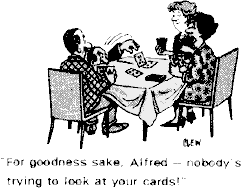
Ephemera
Some collectors enjoy items connected with playing cards, such as score cards, markers, ash trays, glasses, erasers, key rings, post cards, advertisements, brochures, stickers etc. Whatever you may decide to collect, it will lead to new discoveries, hours of 'hunting' and much pleasure.

By Simon Wintle
Member since February 01, 1996
Founder and editor of the World of Playing Cards since 1996. He is a former committee member of the IPCS and was graphics editor of The Playing-Card journal for many years. He has lived at various times in Chile, England and Wales and is currently living in Extremadura, Spain. Simon's first limited edition pack of playing cards was a replica of a seventeenth century traditional English pack, which he produced from woodblocks and stencils.
Trending Articles
Popular articles from the past 28 days
Related Articles
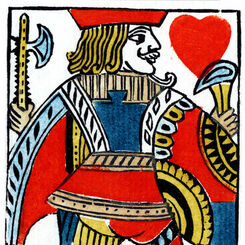
Woodblock and Stencil Jack of Hearts
A limited edition art print of the Jack of Hearts 1984 woodblock joker.
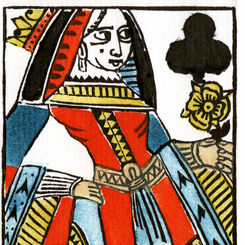
Woodblock and Stencil Queen of Clubs
A limited edition art print of the Queen of Clubs 1984 woodblock joker.
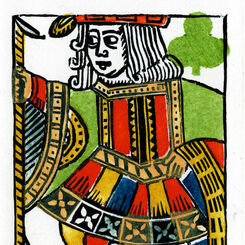
Woodblock and Stencil Jack of Clubs
A limited edition art print of the Jack of Clubs 1984 woodblock joker.
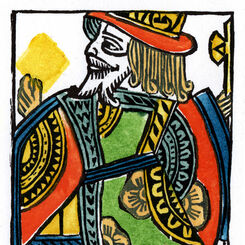
Woodblock and Stencil King of Diamonds
A limited edition art print of the King of Diamonds 1984 woodblock joker.
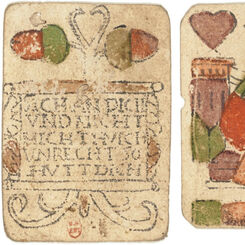
Early German playing cards
Some early examples of popular German playing cards from the XV and XVI centuries.
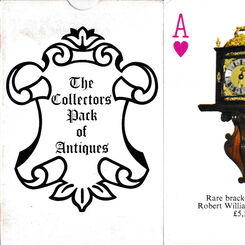
Collectors pack of Antiques
Collectors pack of Antiques playing cards published by Collectors Cards, Abertillery, South Wales, c...
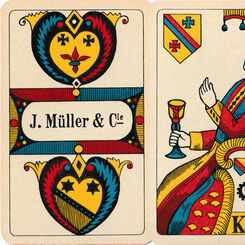
Standard Swiss-German pattern (single-ended)
20th century version of a single-ended Swiss-German pattern pack for the game of Jass.
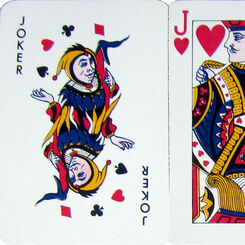
English pattern from Nigeria
A standard pack from the most populous country in Africa.
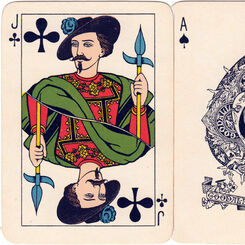
Goodall’s modernised Wüst House pattern playing cards
A remodelled version of the first Wüst house pattern.
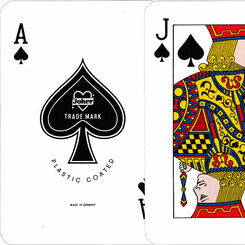
English pattern by Bielefelder Spielkarten
Standard designs by Bielefelder Spielkarten GmbH, Bielefeld, Germany, c1966.

English pattern from Portugal
English pattern by Litografia Maia, Porto, Portugal, c.1960.
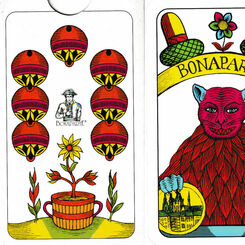
Bohemian pattern by Bonaparte
Standard Bohemian pattern designs by Bonaparte, Plzeň, Czech Republic, c.2000.
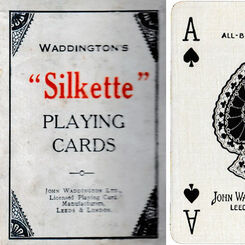
Waddington’s “Silkette” Playing Cards
Cards made by John Waddington Ltd. for the Madras Club, Chennai (formerly Madras), India, c.1930.
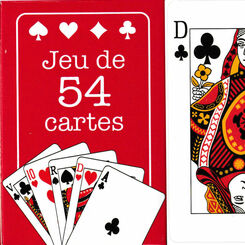
Jeu de 54 cartes
Jeu de 54 cartes, completely anonymous, designed to resemble locally produced French packs.
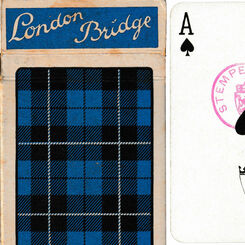
London Bridge NR.18
A brand name used in Norway over a number of years.
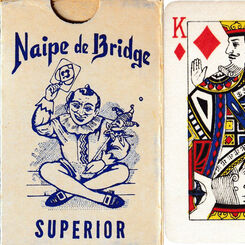
Naipe de Bridge
Standard English pattern pack made in Ecuador, c.1970.
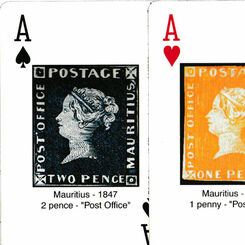
Rare Stamps of the World
Fifty-five rare stamps of the world in full colour, published jointly by David Feldman SA of Switzer...
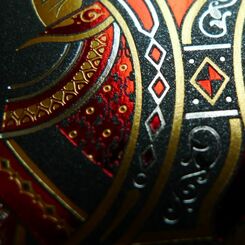
Luxury Collectable Playing Cards
Luxury packs of cards have been produced since the 15th century, a trend that is very popular among ...
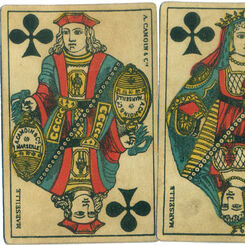
A. Camoin & Cie
This deck was inherited from ancestors, it has has a family history surrounding it. Details of the l...
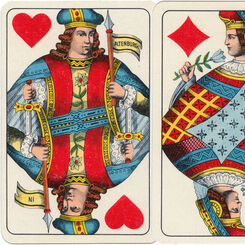
Kaffeehaus-Pikett
Kaffeehaus-Pikett featuring the old Viennese Large Crown pattern, made by ASS.
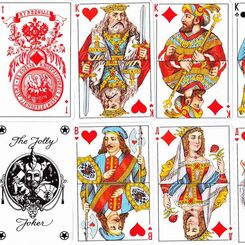
Epokha vozrozhdeniya (Age of Enlightenment)
Epokha vozrozhdeniya (Age of Enlightenment): this pack has effectively become the Russian standard. ...
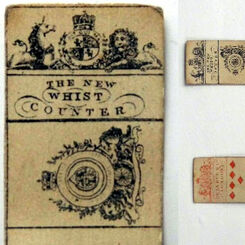
Why do we Collect? My 20 Favourite Items
I suppose people collect for different reasons, rarity, quality, ingenuity of design, sentimental va...
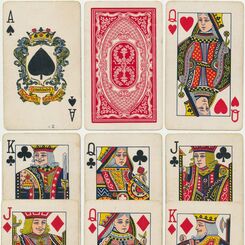
A Case Study
Case Study: using detective work to identify and date a pack discovered in charity shop.
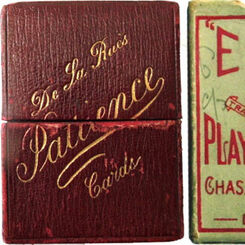
Patience Cards and their Boxes
Patience Cards and their Boxes by Tony Hall.
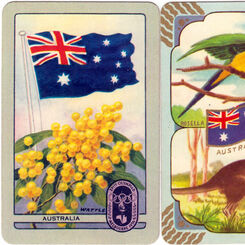
Collecting Playing Cards with Jan Walls
I collected playing cards when I was in primary school, by Jan Walls.
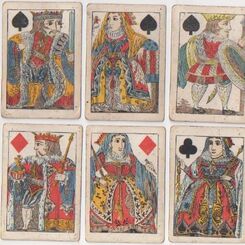
69: My Collection
This is an archive list of my collection. I hope it will be of use and interest to others.
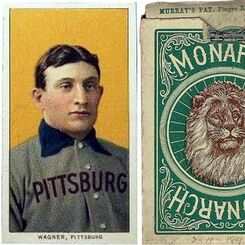
Is Card Collecting an Investment?
“Is Card Collecting an Investment?” - an article by Rod Starling.
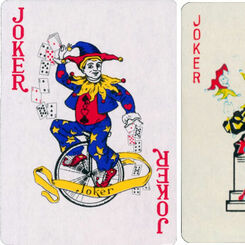
Chinese Jokers
Chinese playing card makers have probably produced the widest variety of jokers of any single part o...
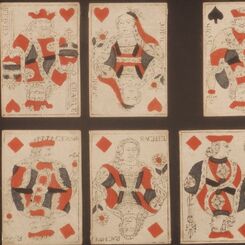
64: The descendants of the French regional patterns: 2
A continuation of the development of the off-spring of the Paris patterns and a few examples of how ...
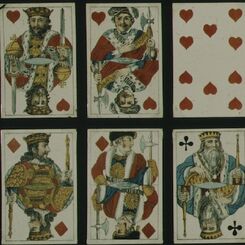
63: The descendants of the French regional patterns: 1
A great many regional patterns were exported from France and subsequently copied elsewhere. Some of ...
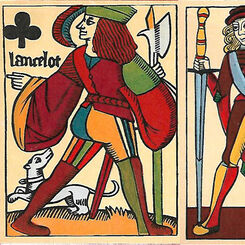
A Look Back with Hope for the Future
“A Look Back with Hope for the Future” by Rod Starling
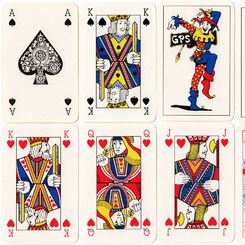
Modern English Court
Modern English court style by Games & Print Services Limited, c.1997.
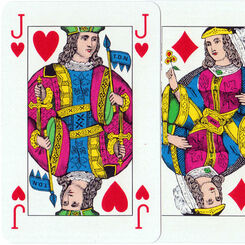
Dal Negro Bridge set
Dal Negro Bridge set featuring old Vienna pattern courts.
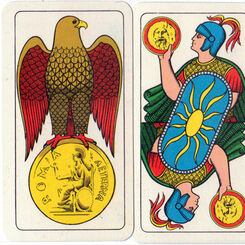
Carte Romane
“Carte Romane” designed by Giorgio Pessione, 1973, celebrating the history of Rome.
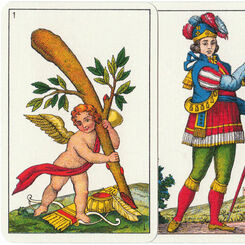
Sarde Pattern
Sarde pattern published by Modiano, c.1975, based on early XIX century Spanish model.
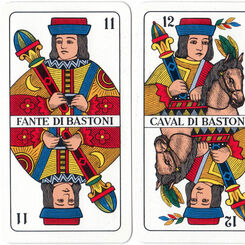
Triestine Pattern
The Triestine pattern is derived from the Venetian (Trevisane) pattern but with its own characterist...
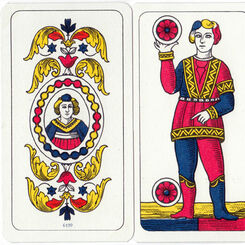
Trentine Pattern
Trentine Pattern
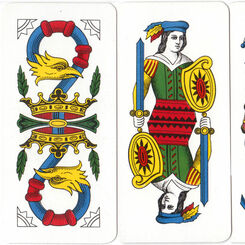
Primiera Bolognese
Primiera Bolognese by Modiano, c.1975
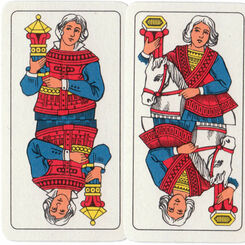
Bergamasche Pattern
Bergamasche Pattern by Modiano, 1970s.
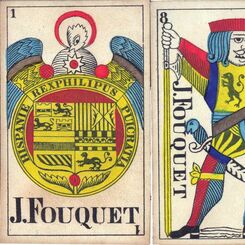
Jonas Fouquet Navarra Pattern
Navarra Pattern by Jonas Fouquet, c.1720 and c.1820.

Navarra Pattern, 1682
Navarra pattern produced for the Pamplona General Hospital Monopoly in 1682.
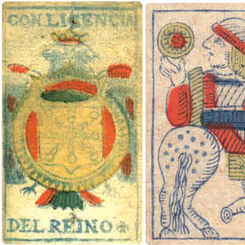
Navarra Pattern
Navarra Pattern produced for the Pamplona General Hospital Monopoly.
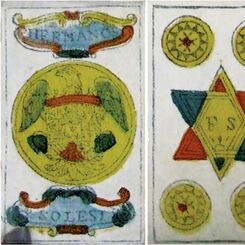
Hermanos Solesio
“Money Bag” pattern by Hermanos Solesi, late 18th c.


